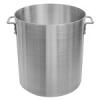Hi AJL 
Allergenic ingredients in the form of dry powders, such as powdered eggs, milk and flour can be readily dispersed in the air and may cross-contaminate other products by settling into ingredients bins, or onto open product or cleaned surfaces.
Air sampling may be required to :
- validate that segregation of areas that do and do not handle allergens are effective
- validate effectiveness of air flow systems
- investigate potential cross-contamination risk due to the production of aerosols when cleaning
A simple way to sample allergens that settle out from the air is by placing open, empty settle plates in the manufacturing environment for a defined exposure time during particular activity (during production/ after production). The contents of the settle plates are testes for allergens. Alternatively a known quantity of extraction solution or product can be placed in the settle plates (speak to laboratory, they should know) which can be tested for allergens.
Consider the time wisely, for example settle plates exposed to the air for one week may show contamination which allergenic material, but if product is only open to the air for a max of a few hours then leaving settle plates open for a week is not appropriate.
Not sure what you manufacturing but, I would leave plates next and slightly away to dry allergens for example flour (gluten) while sieving process.
Do you have allergens claims? For example eggs-free etc
Settle plates are referred to as passive air sampling devices, as only particles of sufficient size and weight settle onto the surface in the exposed period. Active air sampling devices force samples air through a filter at controlled rate; the filter can then be easily removed and analysed following a liquid extraction.
I used Campden BRI guideline no. 71 - Food allergens: practical risk analysis, testing and action levels.
















